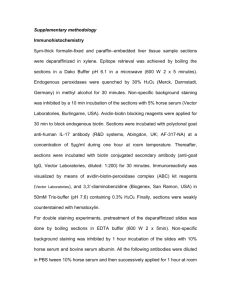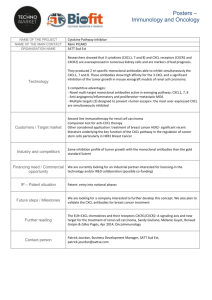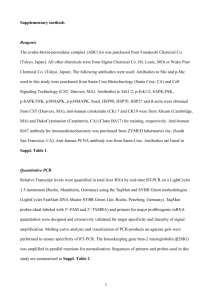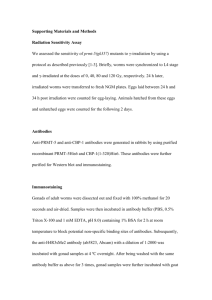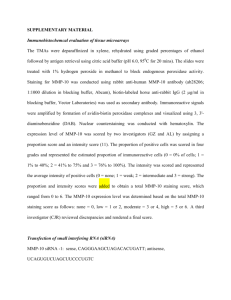Supplemental Methods (doc 37K)
advertisement
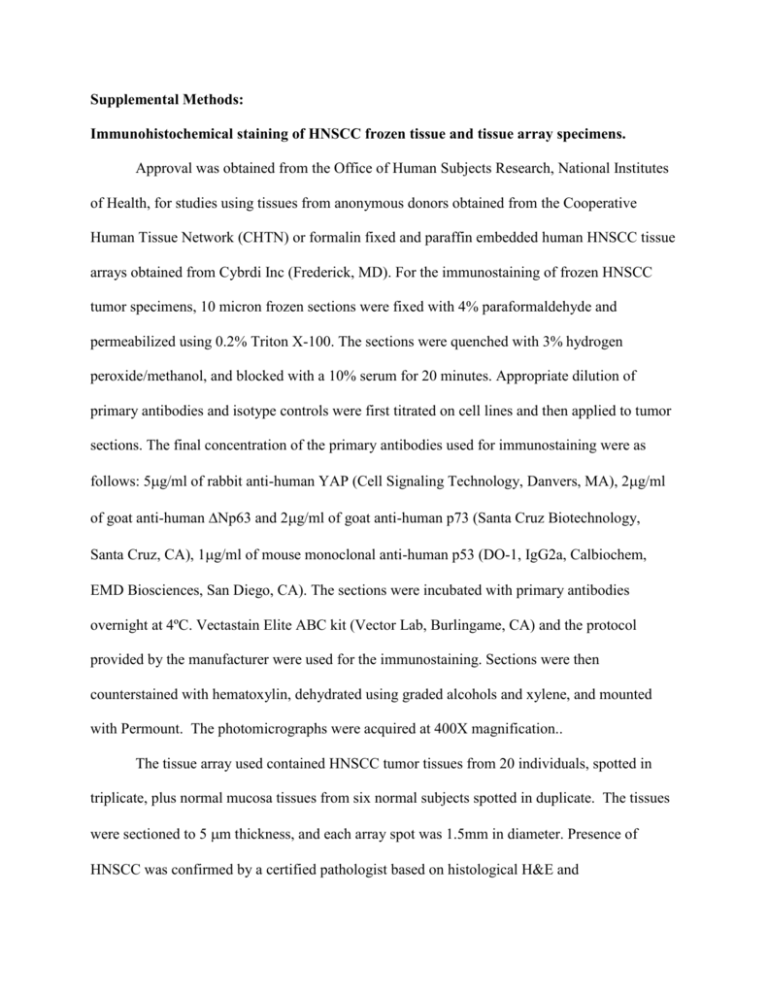
Supplemental Methods: Immunohistochemical staining of HNSCC frozen tissue and tissue array specimens. Approval was obtained from the Office of Human Subjects Research, National Institutes of Health, for studies using tissues from anonymous donors obtained from the Cooperative Human Tissue Network (CHTN) or formalin fixed and paraffin embedded human HNSCC tissue arrays obtained from Cybrdi Inc (Frederick, MD). For the immunostaining of frozen HNSCC tumor specimens, 10 micron frozen sections were fixed with 4% paraformaldehyde and permeabilized using 0.2% Triton X-100. The sections were quenched with 3% hydrogen peroxide/methanol, and blocked with a 10% serum for 20 minutes. Appropriate dilution of primary antibodies and isotype controls were first titrated on cell lines and then applied to tumor sections. The final concentration of the primary antibodies used for immunostaining were as follows: 5g/ml of rabbit anti-human YAP (Cell Signaling Technology, Danvers, MA), 2g/ml of goat anti-human Np63 and 2g/ml of goat anti-human p73 (Santa Cruz Biotechnology, Santa Cruz, CA), 1g/ml of mouse monoclonal anti-human p53 (DO-1, IgG2a, Calbiochem, EMD Biosciences, San Diego, CA). The sections were incubated with primary antibodies overnight at 4ºC. Vectastain Elite ABC kit (Vector Lab, Burlingame, CA) and the protocol provided by the manufacturer were used for the immunostaining. Sections were then counterstained with hematoxylin, dehydrated using graded alcohols and xylene, and mounted with Permount. The photomicrographs were acquired at 400X magnification.. The tissue array used contained HNSCC tumor tissues from 20 individuals, spotted in triplicate, plus normal mucosa tissues from six normal subjects spotted in duplicate. The tissues were sectioned to 5 m thickness, and each array spot was 1.5mm in diameter. Presence of HNSCC was confirmed by a certified pathologist based on histological H&E and immunohistochemical pan cytokeratin staining. The slides were de-paraffinized, fixed and stained with H&E following manufacturer’s suggestions. Appropriate dilution of primary antibodies and isotype controls were first titrated on cell lines and then applied to tumor sections. The final concentration of the primary antibodies used for immunostaining were as follows: 0.2 ng/L of rabbit anti-human YAP (Cell Signaling Technology), 3.9 ng/L of rabbit anti-human phospho-YAP (serine 127) (Cell Signaling Technology), 1 ng/L of IHC specific rabbit antihuman phospho-AKT (serine 473) (Cell Signaling Technology), 2g/ml of mouse anti-human p53 (DO-1, IgG2a, Oncogene, San Diego, CA), The antibodies were incubated with the cells overnight at 4oC. Vectastain Elite ABC kit (Vector Lab, Burlingame, CA) and the protocol provided by the manufacturer were used for subsequent immunostaining steps. Immunohistochemical scoring. IHC scores were based upon the products of percentage positive cells multiplied by stain intensity (0 = negative, 1= weak, 2 = moderate, 3 = strong) in three different high power fields (400x) for each tumor section. To evaluate the immunostaining intensity, each slide was examined on an Olympus BX51 microscope. Representative 400x magnification fields of at least 100 tumor cells were selected and photographed with an Olympus DP70 camera accompanying image software. Immunohistochemitry scoring (Histoscore) was performed using a modified scoring method previously reported by Nenutil, et al. (Nenutil et al., 2005). Briefly, total cells and cells with positive staining were counted and the percent positive cells in each high power field was calculated. Fields were then assigned a relative staining intensity score of 1 for low, 2 for intermediate, or 3 for high staining. The product of the percent positive cells and staining intensity was then derived to create a histoscore of 0-300 for each high power field. To determine statistical significance, p-values were determined (student’s t-test) by comparing high power field scores between each group of patient samples. A value of p≤0.05 was considered statistically significant. A final IHC score was then given to each tumor for each primary antibody. To test if there is a statistically significant relationship between immunostaining intensity of phospho-AKT and phospho-YAP, a univariate analysis between phospho-AKT and phosphoYAP was performed by plotting of the data using the least squares regression method, and then calculating the spearman rank correlation and p-values corresponding to tests of whether the correlation is equal to zero. Antibodies used for Western Blot. Primary antibodies used as indicated by manufacturers instructions are as follows: antiAKT, anti-phospho-AKT (serine 473), anti-β-actin, anti-phospho-YAP (serine 127) and antiYAP (Cell Signaling Technology); anti-TP53 (FL-393), and anti-p63 (4A4) (Santa Cruz Biotechnology); anti-p73 (IMG-246) (Imgenex,San Diego, CA); Anti-14-3-3 and anti-Oct-1 (Chemicon International, Temecula, CA). Real-time reverse transcription-PCR (QRT-PCR). Real-time reverse transcription-PCR was performed using Assays-on-Demand Gene Expression Assay (Applied Biosystems, Foster City, CA). Amplification conditions: activation of enzymes for 2 min (50°C) and 10 min (95°C), followed by 40 cycles at 15s (95°C) and 1 min (60°C). Thermal cycling and fluorescence detection were done using an ABI Prism 7700 Sequence Detection System (Applied Biosystems). Values were normalized to 18S rRNA. Chromatin Immunoprecipitation Assay (ChIP). Precleared chromatin of UMSCC-46 was immunoprecipitated with a rabbit polyclonal antibody against p63 (H-129, Santa Cruz Biotechnology), normal rabbit IgG (Upstate Biotechnology), or a no antibody control. Precipitated DNA was amplified with Platinum Taq DNA Polymerase (Invitrogen) and Power SYBR Green PCR Master Mix (Applied Biosystems). The primers for p63 binding sites of the YAP1 promoter predicted by Genomatix software (B. Yan et al., manuscript in preparation) were: (-2325 to -2295 bp): 5CTGGAGTGCAGTGGTGTGAT-3(forward), and 5-GTGGTGGCATGTTCCTGTAGT3(reverse); (-1522 to -1492bp): 5-GCCCTACCACACCAAGTGATA-3(forward), and 5AGCAAGGAAAAAGTCCGTG-3(reverse). Immunofluorescence staining of cell lines. Immunofluorescence staining of UMSCC lines was conducted according to the manufacturer’s protocol for anti-YAP (Cell Signaling Technology) and secondary goat antirabbit IgG-FITC (Santa Cruz Biotechnology) antibodies. Photomicrographs were acquired at 400X and 1000X magnification. Reference: Nenutil R, Smardova J, Pavlova S, Hanzelkova Z, Muller P, Fabian P et al (2005). Discriminating functional and non-functional p53 in human tumours by p53 and MDM2 immunohistochemistry. J Pathol 207: 251-9.
